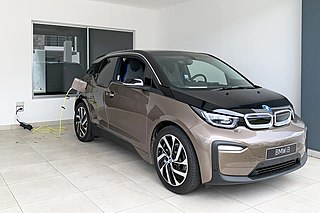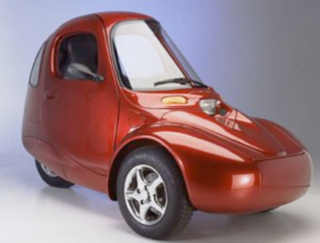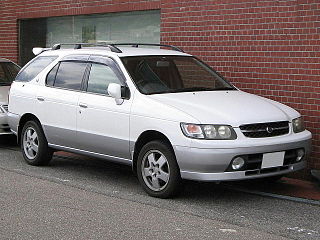
An electric vehicle (EV) is a vehicle that uses one or more electric motors for propulsion. The vehicle can be powered by a collector system, with electricity from extravehicular sources, or can be powered autonomously by a battery or by converting fuel to electricity using a generator or fuel cells. EVs include road and rail vehicles, electric boats and underwater vessels, electric aircraft and electric spacecraft.

The Myers Motors NmG is a single-passenger, three-wheeled, battery electric vehicle designed specifically for commuting and city driving, produced from 1999 into the early 2010s. It was initially produced by Corbin Motors, and made to order after 2005 by Myers Motors. It is a personal electric vehicle (PEV).

The Toyota RAV4 EV is an all-electric version of the popular RAV4 SUV produced by Toyota until 2014. Two generations of the EV model were sold in California, and to fleets elsewhere in the US, with a gap of almost ten years between them.

The Honda EV Plus was an experimental electric vehicle which was the first battery electric vehicle from a major automaker that did not use lead acid batteries. Roughly 340 EV Plus models were produced and released. Production of the EV Plus was discontinued in 1999 after Honda announced the release of its first hybrid electric vehicle, the Honda Insight.

The Nissan R'nessa is a station wagon manufactured by Nissan Motors from 1997 to 2001. According to Nissan, the name derives from "packaging renaissance for versatile, spacious comfort on wheels."
The Progressive Insurance Automotive X Prize was a set of competitions, programs and events, from the X Prize Foundation, to "inspire a new generation of super-efficient vehicles that help break America's addiction to oil and stem the effects of climate change." Progressive Insurance was the title sponsor of the prize, the centerpiece of which is the Competition Division, within which a 10-million-dollar purse was divided between the winners of three competitions.
MIEV (Mitsubishi In-wheel motor Electric Vehicle) or MiEV (Mitsubishi innovative Electric Vehicle) is the name given by Japanese automaker Mitsubishi Motors (MMC) to its alternative propulsion technologies. From late 2006, “MiEV” encompasses all of Mitsubishi Motors’s electric drive systems work, including lithium-ion batteries, in-wheel motors and other technologies related to electric vehicle (EV), hybrid-electric vehicle and fuel-cell vehicles.

Mahindra Last Mile Mobility Limited, formerly known as Mahindra Electric Mobility Limited (2016-2023) and Reva Electric Car Company (2010-2016), is an Indian company based in Bangalore that designs and manufactures compact electric vehicles. The company's first vehicle was the REVAi electric car, available in 26 countries with 4,000 versions sold worldwide by mid-March 2011. Reva was acquired by Indian conglomerate Mahindra & Mahindra in May 2010. After the acquisition, the company launched the electric hatchback e2o in 2013. Today, the company sells electric vehicles in different segments – the electric sedan eVerito, the electric commercial vehicle eSupro, and the Treo range of low maintenance, lithium-ion battery-powered three-wheelers. Recently, Mahindra Electric became the first Indian car manufacturer to cross 170 million kilometres travelled on its fleet.

An electric car or electric vehicle (EV) is a passenger automobile that is propelled by an electric traction motor, using only energy stored in on-board batteries. Compared to conventional internal combustion engine (ICE) vehicles, electric cars are quieter, more responsive, have superior energy conversion efficiency and no exhaust emissions and lower overall vehicle emissions. The term "electric car" normally refers to plug-in electric vehicle, typically a battery electric vehicle (BEV), but broadly may also include plug-in hybrid electric vehicle (PHEV), range-extended electric vehicle (REEV) and fuel cell electric vehicle (FCEV).

A battery electric vehicle (BEV), pure electric vehicle, only-electric vehicle, fully electric vehicle or all-electric vehicle is a type of electric vehicle (EV) that exclusively uses chemical energy stored in rechargeable battery packs, with no secondary source of propulsion. BEVs use electric motors and motor controllers instead of internal combustion engines (ICEs) for propulsion. They derive all power from battery packs and thus have no internal combustion engine, fuel cell, or fuel tank. BEVs include – but are not limited to – motorcycles, bicycles, scooters, skateboards, railcars, watercraft, forklifts, buses, trucks, and cars.

Artega Automobil GmbH & Co. KG is a German sports car manufacturer based in Delbrück, Germany. Founded by Klaus Dieter Frers in 2006, the company's first product was a mid-engined sports coupé released in 2007. In early 2010, a private equity and venture capital firm that already held a stake in Artega took full control. Artega filed for bankruptcy in July 2012. It was reacquired by a company under Frers' control that same year and eventually resumed production, specializing in electric vehicles.
Zotye Auto was a privately owned Chinese automobile manufacturer based in Yongkang, Zhejiang, China. It is owned by Zotye Holding Group and was established in 2005.
Green Vehicles Inc. was a manufacturer of electric cars that operated in California from 2008 to 2011. Their best-known product was the Triac, a three-wheeled car that never entered production.

The Tazzari Zero is a battery electric microcar concept car built by the Tazzari Group, in Imola, Italy, and unveiled in the 2009 Bologna Motor Show. The Tazzari Zero uses a lithium-ion battery pack that delivers an all-electric range of 140 km (87 mi).

The Hyundai Ioniq is a compact five-door liftback manufactured and marketed by Hyundai. The nameplate Ioniq is a portmanteau of ion and unique. It is marketed as the first Hyundai automobile to be offered without a standard internal combustion engine, but rather sold in hybrid, plug-in hybrid, and all-electric variants.

Mercedes-EQ is a series of battery electric vehicles manufactured by Mercedes-Benz. The first model was previewed at the Paris Motor Show in 2016 with the Generation EQ concept vehicle. Mercedes-Benz intends to produce ten EQ models by 2022, three of which will have the Smart brand, representing between 15% and 25% of the company's global sales. All of Mercedes-Benz electric vehicle design and production efforts will target the EQ family.

The Ford Mustang Mach-E is a battery electric compact crossover SUV produced by Ford. The vehicle was introduced on November 17, 2019, and went on sale in December 2020 as a 2021 model. The vehicle is in the Mustang series, with model name Mach-E inspired by the Mach 1 variant of the first-generation Mustang. The car won the 2021 North American SUV of the Year Award.

The Chery eQ5 is an electric compact crossover SUV by Chery.

The Honda Prologue is a battery electric mid-size crossover SUV jointly developed by Honda and General Motors that is marketed in North America. Announced in October 2022 with sales starting in March 2024, it is Honda's first major electric vehicle following a number of low volume battery electric vehicles previously sold by Honda in North America, including the Honda Clarity, Honda Fit, and the experimental Honda EV Plus. Based heavily on the Chevrolet Blazer EV, the Prologue is comparable in size with the ICE-powered Passport.

Okinawa Autotech is an Indian electric vehicle company, headquartered in Gurgaon, Haryana. It was founded by Jeetender Sharma and Dr Rupali Sharma in 2015.

















